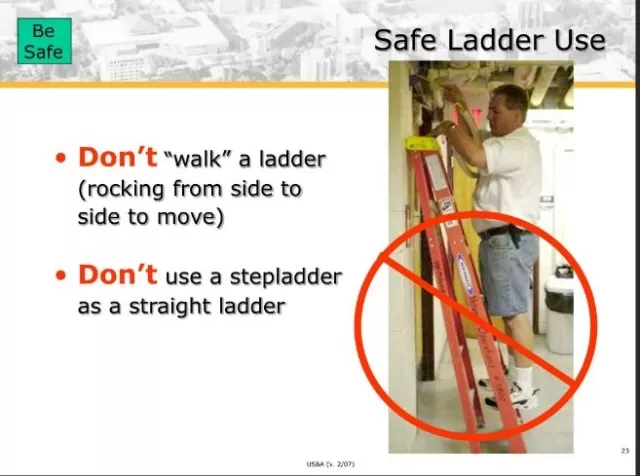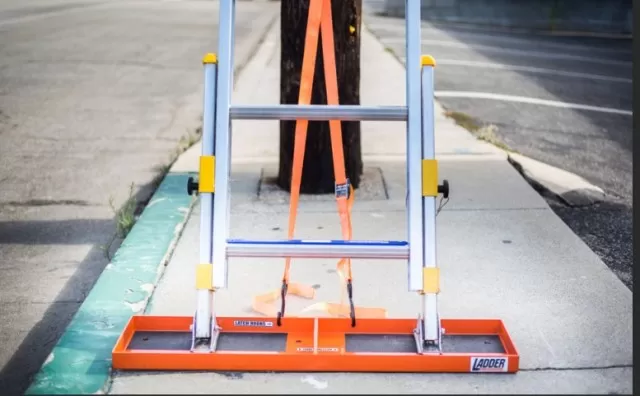Ladder Safety: Avoid These Errors. When embarking on home maintenance projects that require a ladder, safety should always be your top priority.
By sidestepping avoidable errors, you can effectively shield yourself from unexpected trips to the emergency room and ensure that your endeavors remain accident-free.By adhering to these fundamental safety guidelines, you can embark on your home maintenance projects with confidence, knowing that you’re minimizing risks and prioritizing your well-being.
Extending Your Reach Safely: Essential Ladder Safety Tips for Injury-Free Projects

In our quest to accomplish various tasks that require reaching elevated areas, it’s crucial to prioritize ladder safety.
The importance of this cannot be overstated, especially considering the alarming statistics. According to the World Health Organization, the United States witnesses over 164,000 injuries requiring emergency room treatment and approximately 300 fatalities each year due to ladder-related falls.
Surprisingly, most of these accidents occur from heights of 10 feet or even lower, underlining the need for vigilance even in seemingly minor tasks.
Ladders stand as fundamental tools for a wide array of do-it-yourself endeavors, enabling us to tackle projects like painting interiors, clearing out gutters, and adorning our surroundings with festive decorations.
However, it’s a grim reality that improper ladder usage can quickly turn into tragedy. Instead of becoming a part of these alarming statistics, let’s commit to safeguarding our well-being by avoiding the critical mistakes that often lead to accidents when working with ladders.
By absorbing and applying these ladder safety guidelines, you not only protect yourself but also promote a culture of precaution.
Remember that the convenience ladders offer comes hand in hand with responsibility—every step taken with care is a step towards a safer and more injury-free environment.
Selecting the Appropriate Ladder: A Foundational Aspect of Safety
Embarking on a journey of ladder safety necessitates a comprehensive understanding of the ladder itself.
Indeed, ladders exhibit a diverse range of types, compositions, and weight-bearing capabilities. Making the correct choice aligning with the environment and task at hand is paramount. An example scenario could involve opting for an A-frame ladder with higher weight capacity instead of settling for a low-capacity step-stool when replacing a first-floor window. Another critical consideration involves choosing between an aluminum ladder near electrical lines or a non-conductive fiberglass ladder, with the latter being imperative to avert the risk of electrocution. .
The significance of this decision-making process cannot be underestimated, as it directly influences the vulnerability to an array of injuries spanning from falls to electrical accidents.
Evaluating the unique demands of the project, the surrounding environment, and the load-bearing requirements of the materials being transported on the ladder are all pivotal factors when making your choice. By meticulously weighing these factors and selecting the most suitable ladder for the task, you inherently amplify safety precautions while minimizing potential hazards.
Remember, the right ladder, thoughtfully chosen, serves as your steadfast partner in securing both successful project outcomes and your personal well-being.
Overlooking the Importance of Height Consideration

One of the fundamental elements in ladder safety is giving due consideration to the factor of height.
In the realm of indoor projects spanning two to eight feet, step-stools, A-frame ladders, and articulated ladders prove to be optimal choices. Conversely, when outdoor tasks demand elevations of 13 feet or more, an extension ladder or a taller articulated ladder becomes the preferred solution.
However, it’s essential to acknowledge that ladder types exhibit a spectrum of heights, and the selection process hinges on this crucial factor.
Selecting a ladder that’s either too short or too tall in relation to your own height or the nature of the project can inadvertently introduce risks.
The temptation to stand on tiptoes or contort yourself to reach the work area arises, potentially compromising the ladder’s stability and creating a precarious situation that might lead to a fall. The quest for safety, therefore, hinges on finding a harmonious match between your height, the project’s demands, and the ladder’s dimensions.
When navigating the labyrinth of ladder choices, it’s wise to remember that an individual’s height profoundly impacts the effective reach.
For instance, a person standing at five feet six inches can only extend their reach by four feet beyond the ladder’s height. To illustrate, if the ladder is four feet tall, this person can comfortably access a surface situated eight feet above the ground.
By engraining these height considerations into your ladder shopping mindset, you are equipping yourself with the knowledge required to make prudent choices that both elevate your efficiency and safeguard your well-being.
Prioritize Stability: Mind Your Ladder\’s Foundation
Exercising caution extends beyond your choice of ladder and reaches the very foundation upon which it rests.
Before you hastily position your ladder, it’s imperative to exercise prudence when selecting the surface upon which it will be placed. Refrain from underestimating the significance of this decision, for placing your ladder on an uneven or slippery terrain can lead to dire consequences.
A bed of rocks or mulch, a sheet of plastic, a recently waxed floor, or a damp driveway might appear innocuous, but they can present significant hazards.
The ladder’s base could exhibit instability as your weight redistributes while climbing or working on the rungs. This seemingly innocuous movement can initiate a perilous chain reaction, causing the ladder to unexpectedly shift and slide away from your intended position.
Such an occurrence could compromise your balance and result in a hazardous fall.
To cultivate an environment of utmost ladder safety, it’s indispensable to adhere to the principle of stability.
This entails confining ladder setup to solid, level surfaces that are devoid of slipperiness. By doing so, you ensure that all ladder feet maintain uninterrupted contact with the ground or floor, establishing a secure and reliable foundation.
This seemingly simple precaution is instrumental in curbing potential accidents, enabling you to carry out tasks aloft with confidence and peace of mind.
Securing Stability: Locking in Ladder Spreaders and Devices

It’s easy to underestimate the importance of ensuring your ladder’s stability, especially for what seems like a minor task.
However, neglecting to lock the spreaders or engaging the locking device on your ladder can lead to unexpected consequences. While a simple light bulb change may not appear to require such precautions, the truth is that this oversight can result in perilous situations.
The spreaders, those metal braces connecting the front and rear of the ladder, play a pivotal role in maintaining the ladder’s structural integrity.
If these spreaders are bent or if there’s a lack of spreaders altogether, failing to lock the mechanism can have serious repercussions. The ladder could unexpectedly collapse inwards, causing abrupt movements that may jolt you either forward or backward.
The seemingly innocuous act of not locking in these components can thus transform into a potentially dangerous situation.
Regardless of the task’s magnitude, whether it’s as simple as changing a light bulb or involves more extensive work, the imperative remains the same.
To safeguard your well-being and guarantee the ladder’s reliability, it’s crucial to adhere to the practice of locking the spreaders or engaging the locking mechanism before stepping onto the ladder. This uncomplicated yet vital measure ensures that the ladder remains securely in its open position, allowing you to work at elevation with confidence and without unnecessary risk.
*The information is for reference only.